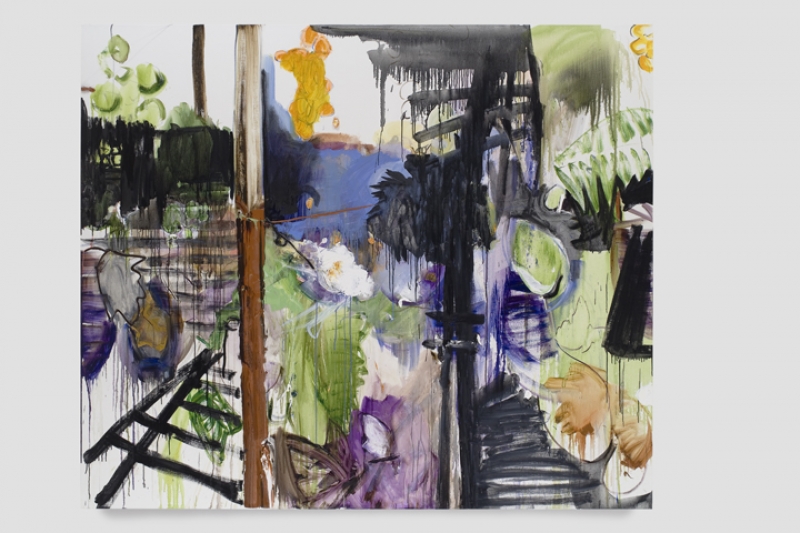December 2008, Elisabeth Neel @ Deitch Projects

Elizabeth Neel,
Yankee Doodle, 2007
Oil on canvas
76 x 90 inches
193.4 x 228.6 cm
Photo credit: Tom Powel
Courtesy of Deitch Projects
Elizabeth Neel
“Make No Bones”
November 6 - December 6, 2008
Deitch projects
76 Grand Street
New York, NY 10013
Against the warm, white walls at Deitch projects, which extend upwards of twenty odd feet, the little terriers in black & white rain gear and white poodles visiting Elizabeth Neel’s opening are like seraphim on the white cement floor. The human figures up against Neel’s dripping oil painting, “Count to Ten,” (83” x 96,” 2008) of interiors in tangerine, white washed over sepias have architectonic references and Rymanesque, white windows.
What I immediately noticed is that Neel has made an academic contribution to abstract painting. There seems to be a shelf or a stroke of paint upon which the more organic forms rest. This plane, expropriated from portrait painting, is hard to describe. By envisioning it as, not a picture plane, but rather a strategically placed stroke of paint, one has a clue all the way back into the sacred cow of Renaissance painting. In the real Da Vinci code or the old masters’ art credo, there has always been a time to be expressive and a time to denote the earth and the ground. It’s quite different than the figure/ground that’s usually conceived of in abstract painting where there is an interaction between two colors.
Portraiture’s ground defines a kind of horizon line or new perspective inside the edges of the canvas. Whereas breaking up the picture plane has always been obvious when dissecting a painting on a semi-square canvas, a ledge or a shelf-like seat is a unique contribution when the images are accumulating in the painting in a pre-climactic way. This may lead up to a definite idea or in Elizabeth Neel’s paintings, this climax seems to be the release of her subconscious. Animistic passage painting such as a perfect breast or a fish within a wild, spherical shape of pastel mud of rose and viridian green suddenly bleeds through the geometric shape. What looks like a subconscious allusion to her grandmother, Alice Neel emerges as a grey splatter of a perfect silhouette in “Sideshow“ (76“ x 85,” 2008).
Neel visually describes it in “Yankee Doodle” (76” x 90,” 2007) with repeated steps, but the concept of a swift stroke of paint being a seat for something else is established, but this discovery stands out in a Zen-like way. Her grandmother, Alice Neel was one of the greatest American portrait painters of the 20
th century. Rafael Soyer, Reginald Marsh, Norman Rockwell and the school of Social Realism all were her contemporaries.
Suddenly, further on during the opening, Marilyn Minter wandered in smiling. She is one of the most widely shown photographer/artists in the world. On such a rainy night, she seems soothed by a large figurative breast, perfectly manifested in washes. This is surrounded by golden ochre balls dripping paint. Motion studies in black and sepia, a fish mouth lead to double, vertical white marks.
Diverting again completely into the abstract, there is a relationship between Neel and the late painter, Joan Mitchell. Mitchell’s large and colorful, childlike paintings are currently on view at Cheim & Reed Gallery in Chelsea. Two small paintings with black backgrounds painted around colors which resemble little plates of fireworks rotating confirm that similarity.
Easily and festively executed, Elizabeth Neel’s paintings encompass their edges and attend to the spaces within. Not only that, but Neel is able to paint like a fashion stylist or as if combining high fashion sketches with abstraction. She is also concerned with art history; Barnett Newman and Ron Gorchov, for example, are influences. Cutting the square shapes into three rectangles, the cadmium green light, opaque lavender, strong handed black, cobalt violet and cadmium yellow orange step up winding staircases of light and color.
In Deitch project’s smaller room are ten works on paper. Sap green, ultramarine blue, juane brilliant, raw umber and Venetian red are splatter painted and the brush is twisted around linear platforms. Sometimes a white form, which reminds me of Philip Guston‘s work, appears. Twisting around in multicolor, the relationships between figure/ground fit nicely into the picture plane, softly, against jagged edges. Elizabeth Neel definitely learned something from portraiture and figurative art and brought it to abstract art where it can play a part in today’s painting vocabulary.
Looking up close, I am reminded of miniatures of the plate paintings by Julian Schnabel, but these paintings are almost impressionistic. While expropriating imagery from her contemporaries seems to be an important part of Neel’s process, the platform stroke in is like a Master’s thesis and a sharing of her precious experience as granddaughter of iconographic portrait painter, Alice Neel.
whitehot gallery images, click a thumbnail.

Claudia Schwalb
Claudia Schwalb graduated from Pratt Institute in 1974. She was an emerging artist during the Minimalist movement in the 1970's. She was raised in New York City during the Abstract Expressionist era. Claudia was the youngest artist ever to have a solo exhibition at The Clocktower/P.S.1 in 1977. Claudia went on to write for Barbara Rose's Journal of Art and was one of the Contributing Editors of Cover/Arts New York along with John Yau and Judd Tully (Editor-at-Large for Arts & Auction). She was Curator of the Knitting Factory and a television news transcriber for Peter Jennings' World News Tonight. Subsequently, Claudia transcribed two movies, "Refuge" and "Interview with the Dalai Lama" which played at the Quad last year. claudschwa@aol.com
view all articles from this author











